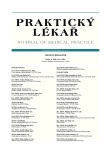Current role of endoscopic ultrasound investigation in the diagnosis of pancreatic diseases – our experiences
Authors:
T. Krechler; M. Dvořák; T. Švestka
Authors‘ workplace:
Přednosta: prof. MUDr. Aleš Žák, DrSc.
; 4. interní klinika 1. LF UK a VFN Praha
Published in:
Prakt. Lék. 2012; 92(1): 35-39
Category:
Of different specialties
Overview
The diagnosis of pancreatic diseases is still problematic. Non-invasive methods in diagnosis are the most important :
- abdominal ultrasound,
- computerised tomography,
- magnetic resonance,
- positron emission tomography.
- 156 patients (21.6 %) had been diagnosed with chronic pancreatitis (or suspicion),
- 148 patients (20.5 %) had pancreatic cancer (or suspicion), and
- 49 patients (6.8 %) had cystic tumour of the pancreas (or suspicion).
According to our results, endoscopic ultrasound has an irreplaceable role primarily in the
- differential diagnosis of focal lesions,
- diagnosis of small lesions of the pancreas,
- and early diagnosis of chronic pancreatitis.
Key words:
differential diagnosis, endoscopic ultrasound, pancreatic cancer, chronic pancreatitis, cystic tumour of the pancreas
Sources
1. Napoleon, B., Dumortier, R., Kerien-Souquet, O. et al. Do normal findings at biliary endoscopic ultrasongraphy obviate the need for endoscopic retrograde cholangiography in patiens with suspicion of common bile duct stone? A prospective follow-up study of 238 patients. Endoscopy 2003, 35, p. 411-415.
2. Catalano, M.F., Sahai, A., Levy, M. et al. EUS-based criteria for the diagnosis of chronic panceatitis: the Rosemont classification. Gastrointestal. Endosc. 2009, 69, p. 1251-1261.
3. Buscail, I., Escourrou, J., Moreau, J. et al. Endoscopic ultrasonography in chronic pancreatitis: a comparative prospective study with conventional ultrasonography, computed tomography, and ERCP. Pancreas 1995, 10, p. 251-257.
4. Sahai, A.V., Zimmermann, M., Aabakken, L. et al. Prospective assessment of the ability of endoscopic ultrasound to diagnose, exclude, or establish the severity of chronic pancreatitis found by endoscopic retrograde cholangiopancreatography. Gastrointest. Endosc. 1998, 48, p. 18-25.
5. Nakaizumi, A., Uehara, H., Iishi, H. et al. Endoscopic ultrasonography in diagnosis and staging of pancreatic cancer. Dig. Dis. Sci. 1995, 40, p. 696-700.
6. Palazzo, I., Roseau, G., Gayet, B. et al. Endoscopic ultrasonography in the diagnosis and staging of pancreatic adenocarcinoma. Results of a prospective study with comparison to ultrasonography and CT scan. Endoscopy 1993, 25, p. 143-150.
7. Yasuda, K., Mukai, H., Nakajima, M. et al. Staging of pancreatic carcinoma by endoscopic ultrasonography. Endoscopy 1993, 25, p. 151-155.
8. Gress, F.G., Hawes, R.H., Savides, S.J. et al. Role of EUS in the preoperative staging of pancreatic cancer: a large single-center experience. Gastrointest. Endosc. 1999, 50, p. 786-791.
9. Morris-Stiff, G., Ascopel, X., Barry, J.D. et al. Selective use of endoscopic ultrasound in the evaluation of carcinomas of the pancreatic head. Dig. Surg. 2011, 28, p. 373-378.
10. Catanzaro, A., Richardson, S., Veloso, H. et al. Long-term follow-up of patients with clinically indeterminance suspicion of pancreatic cancer and normal EUS. Gastrointest. Endosc. 2003, 58, p. 836-840.
11. Klapkan, J.B., Chang, K.J., Lee, J.G., Nguyen P. Negative predictive value of endoscopic ultrasound in a large series of patiens with a clinical suspicion of pancreatic cancer. Am. J. Gastroenterol. 2005, 100, p. 2658-2661.
12. Canto, M.I., Coggins, M., Hruban, RH. et al. Screening for early pancreatic neoplasia in high-risk individuals: a prospective controlled study. Clin. Gastroenterol. Hepatol. 2006, 4, p. 766-781.
13. Poley, J.W., Kluijt, I., Gouma, D.J. et al. The yield of first-time endoscopic ultrasonography in screening individuals at high risk to develop pancreatic cancer. Am. J. Gastroenterol. 2009, 104, 2175-2181.
14. Kliment, M., Urban, O., Cegan, M. et al. Endoscopic ultrasound - guided fine needle aspiration of pancreatic masses: utility and impact on managment of patients. Scand. J. Gastroenterol. 2010, 45, 1372-1379.
15. Mallery, J.S., Centeno, B.A., Hahn, P.F. et al. Pancreatic tissue sampling guided by EUS, CT/US, and Surgery: a comparison of sensitivity and specificity. Gastrointest. Endosc. 2002, 56, p. 218-224.
16. Chang, K.J., Nguyen, P., Ericsson, R.A. et al. The clinical utility of endoscopic ultrasound - guided fine-needle aspiration in the diagnosis and staging of pancreatic carcinoma. Gastrointest. Endosc. 1997, 45, p. 387-393.
Labels
General practitioner for children and adolescents General practitioner for adultsArticle was published in
General Practitioner

2012 Issue 1
Most read in this issue
- Current role of endoscopic ultrasound investigation in the diagnosis of pancreatic diseases – our experiences
- Psychoactive substances abuse and diabetes mellitus
- Potentially inappropriate (risky) drugs at geriatric patients Expert consensus for the Czech Republic 2012
- A survey of motivational factors in non-medical health professionals
